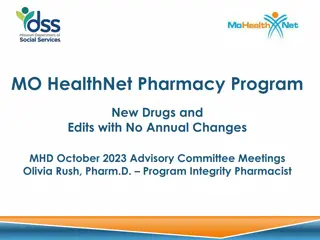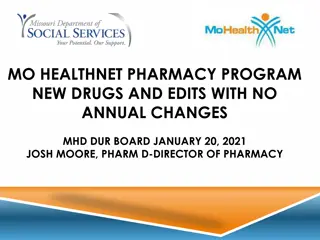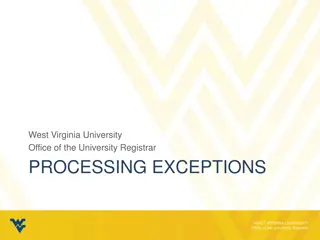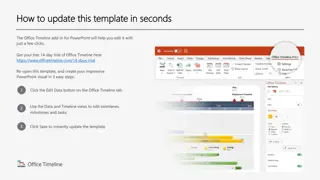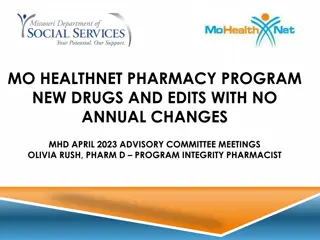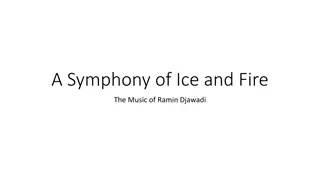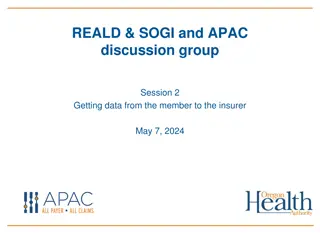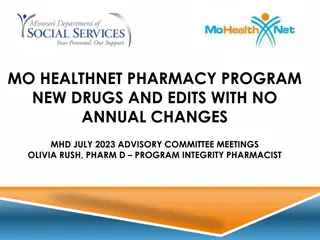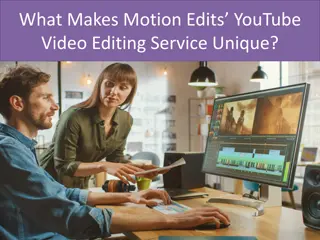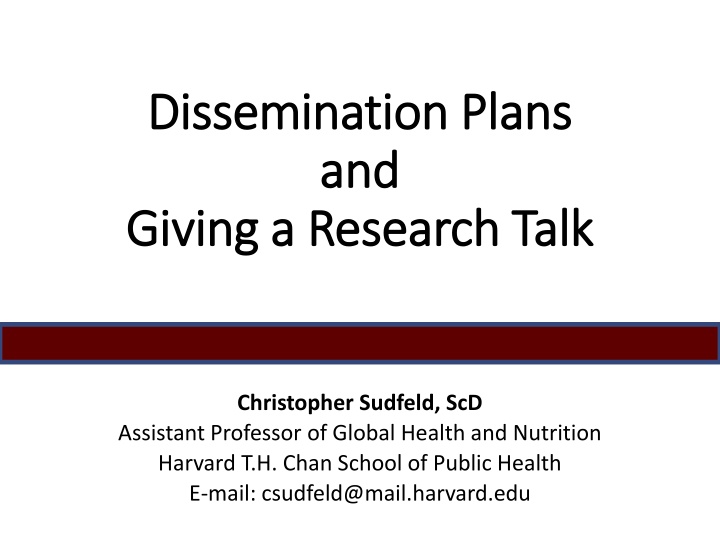
Effective Dissemination Strategies for Research Talks and Knowledge Translation
Learn about effective dissemination plans, constructing research talks, and the importance of knowledge translation in research. Discover general lessons in dissemination, developing a dissemination strategy, reviewing past efforts, setting dissemination objectives, and identifying target audiences for successful knowledge sharing. Enhance your research communication skills and reach your desired audience effectively.
Download Presentation

Please find below an Image/Link to download the presentation.
The content on the website is provided AS IS for your information and personal use only. It may not be sold, licensed, or shared on other websites without obtaining consent from the author. If you encounter any issues during the download, it is possible that the publisher has removed the file from their server.
You are allowed to download the files provided on this website for personal or commercial use, subject to the condition that they are used lawfully. All files are the property of their respective owners.
The content on the website is provided AS IS for your information and personal use only. It may not be sold, licensed, or shared on other websites without obtaining consent from the author.
E N D
Presentation Transcript
Dissemination Plans Dissemination Plans and and Giving a Research Talk Giving a Research Talk Christopher Sudfeld, ScD Assistant Professor of Global Health and Nutrition Harvard T.H. Chan School of Public Health E-mail: csudfeld@mail.harvard.edu
Talk Outline 1. Dissemination Plans 2. Constructing a Research Talk 3. Updates from Fellows 2
Dissemination aka Knowledge Translation (KT) Actively spreading research evidence to target audiences via specified channels using planned strategies 3
General Lessons in Dissemination Passive approaches are often ineffective Stakeholder engagement in research process enhances dissemination Measures of academic impact differ in importance for policy and practice audiences Brownson RC, et al. J Public Health Manag Pract. 2018 4
Developing a Dissemination Strategy WHO Implementation Research Toolkit 5
1. Review Past Dissemination Efforts Informal research team conversations to stakeholder surveys How has research team disseminated information in the past? How did the audience respond? How many people did it reach Did it reach the intended audiences What else worked/didn t work? 6
2. What are the Dissemination Objectives? Brainstorm what the research team hopes to accomplish through the dissemination process Why does the team wish to communicate the findings? What is the goal? Increase awareness, inform, engage, promote 7
3. Determine Your Audience Higher likelihood of success when dissemination strategy is targeted to the characteristics of a desired audience Public Health Practitioners Policy Makers General Public 8
4. Develop Messages for the Audience Effective messages explain: What your research results mean Why are they are important What action should be taken as a result Messages should be based on what the audience wants to know and in terms they understand Make messages clear, simple, and action-oriented 10
5/6. Determine Approach and Channel Tailor your approach / communication medium to the audience Community meetings One-on-One communication Websites Social Media Email messages Working Groups Policy Briefs Technical Reports Scientific Seminars Conferences Scientific Publications 11
7. Review Available Resources and Partnerships Dissemination activities usually costs time and $ Are other partners disseminating results? Are joint meetings beneficial? Are there NGO working groups or technical advisory groups? 12
8. Consider Timing and Windows of Opportunity Is there an important order of audiences for your dissemination plan? Is there a strategic time for dissemination? 13
9. Evaluation of Dissemination Efforts Internally document what works and what does not work Store documents/infographics for future use Documents costs associated with dissemination methods 14
Agency for Healthcare Research and Quality Dissemination Planning Tool See AHRQ Planning Tool sent via email 15
How have you disseminated your research findings? 17
Part II Part II Constructing a Research Talk Constructing a Research Talk
Major Elements of Research Talks Mastery of the subject Engaging the audience Clarity of expression 19
Relevance Who is my audience? What do they need to know? What would interest them? 20
Communication Tell them what you want to say Say it . . . Tell them again 21
Delivering the Talk Speak slowly and clearly Talk to the audience Time your talk and practice 22
Information Information Volume Comprehensive is too much Methods Audiovisuals Handouts Interactive vs. passive 23
Slide Preparation: Data Distill the data Avoid absolute numbers if % will do Summarize results in the slide title 24
Tables Present Quantitative Data NOT Trends 25
Slide Preparation: Prose Use phrases, not sentences No more 6 lines/slide Can you read it hand-held? 26
Slide Preparation: Prose Largest font possible No distracting animations Three colors MAX NOT red, blue or purple text Optimal text/background include: Black/Dark blue text on white background White on dark blue background 27
Chilean Exports Fresh fruit leads Chile's export mix - Chile emerges as major supplier of fresh fruit to world market due to ample natural resources, consumer demand for fresh fruit during winter season in U.S. and Europe, and incentives in agricultural policies of Chilean government, encouraging trend toward diversification of exports and development of nontraditional crops - U.S. Dept. of Agriculture, Economic Research Service Report Chile is among the developing economies taking advantage of these trends, pursuing a free market economy. This has allowed for diversification through the expansion of fruit production for export, especially to the U.S. and Western Europe. Chile has successfully diversified its agricultural sector to the extent that it is now a major fruit exporting nation. Many countries view Chile's diversification of agriculture as a model to be followed. Meanwhile, the U.S. remains the largest single market for Chile's fruit exports. However, increasing demand from the EC and Central and East European countries combined may eventually surpass exports to the U.S., spurring further growth in Chile's exports. If you ve read this far, your eyes probably hurt and you ve been reading this tedious long-winded text instead of listening to me. I m insulted- can t you see I m doing a presentation up here? Look at me! Congratulations, however, on having such good eyesight.
Beginner Motorcycles My personal favorite: the Suzuki Savage Light weight (~380lbs) Adequate power (650cc engine) Low seat height fits most riders
Racquetball Fundamentals 2, 3, or 4 players. 1 player serves, other returns. Only serving player can score. Served ball must land past serving line and cannot hit back wall. Ball can only bounce once before striking front wall but ball does not have to bounce.
Murphys Law Whatever can go wrong, Will go wrong Video equipment will work - Test it ! Load presentation before talk Equipment won t crash/power goes out - backup Handout 32
Why use handouts? Helps remind / shareable to colleagues Focus on essential points Encourage interaction if integrated into presentation Reference sources 33
Summary Know your Audience Communicate with Appropriate Medium Learn from what works or does not 34
Thank you! Chris Sudfeld, ScD csudfeld@hsph.harvard.edu




